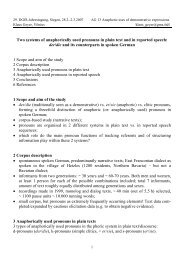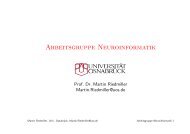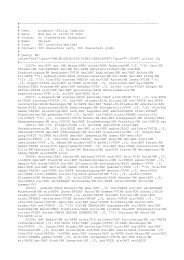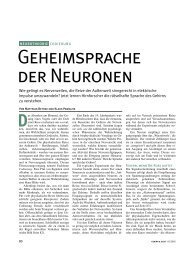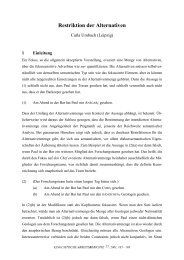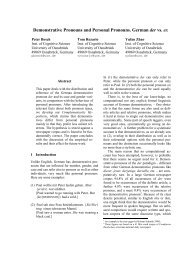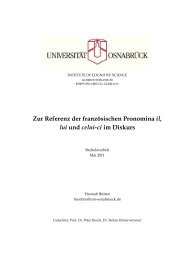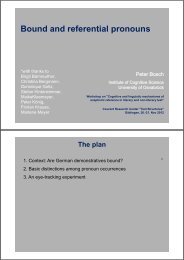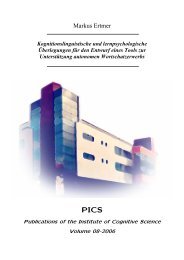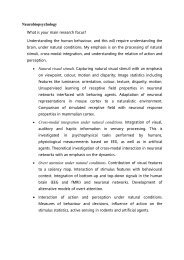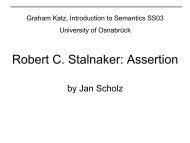Proceedings of the 6th Annual Meeting of the - Heinrich-Heine ...
Proceedings of the 6th Annual Meeting of the - Heinrich-Heine ...
Proceedings of the 6th Annual Meeting of the - Heinrich-Heine ...
You also want an ePaper? Increase the reach of your titles
YUMPU automatically turns print PDFs into web optimized ePapers that Google loves.
3.1 Phonology and etymology<br />
Before I go into <strong>the</strong> details <strong>of</strong> <strong>the</strong> phonology, I want to address a concern that <strong>the</strong> contrast just<br />
mentioned may be <strong>the</strong> result <strong>of</strong> <strong>the</strong> words orthodontist and periodontist beinginsomesensemore<br />
“compositional” than <strong>the</strong> words cranberry and strawberry. This may be true from a historical or<br />
etymological point <strong>of</strong> view; synchronically, however, <strong>the</strong>re is no difference in compositionality.<br />
Speakers <strong>of</strong> English can readily identify <strong>the</strong> morphemes -berry and -dontist, since <strong>the</strong> words that<br />
contain <strong>the</strong>m share some common aspects <strong>of</strong> meaning. But <strong>the</strong> morphemes cran, straw, ortho,<br />
and perio seem just about equally opaque. There is nothing more to <strong>the</strong> meaning <strong>of</strong> cran and<br />
straw o<strong>the</strong>r than <strong>the</strong> kind <strong>of</strong> berry <strong>the</strong>y signify. The term orthodontist is in common use, and it<br />
seems reasonable to assume that speakers learn it as a unit; <strong>the</strong> relation to words like orthodox<br />
and orthography is fairly obscure. The word periodontist is much less familiar, and it is not at all<br />
easy to arrive at its meaning, despite familiarity with <strong>the</strong> morpheme peri in words like perimeter<br />
and periphery. It appears that synchronically, <strong>the</strong> words orthodontist and periodontist are just<br />
as opaque as strawberry and cranberry.<br />
So where do speakers get <strong>the</strong> intuition that orthodontist and periodontist are more compositional<br />
than strawberry and cranberry? I believe this is a phonological intuition, ra<strong>the</strong>r than a semantic<br />
one. Some speakers are more content with boysen and huckleberries than with *cran and<br />
strawberries, even though it is hard to see in what sense it is more compositional. Fur<strong>the</strong>rmore,<br />
speakers are happy to accept ortho and periodontists even when <strong>the</strong>y do not know exactly what<br />
a periodontist is, simply assuming it is some kind <strong>of</strong> dental specialist. This would be hard to<br />
explain if acceptability were tied to <strong>the</strong> lexical meaning <strong>of</strong> <strong>the</strong> word part perio.<br />
Ano<strong>the</strong>r possibility is that compositionality is not an intuition about meaning, but ra<strong>the</strong>r an intuition<br />
about combinatorial properties: speakers are aware that <strong>the</strong> morphemes ortho and peri<br />
form a variety <strong>of</strong> compounds, whereas cran and straw are less productive in this sense (note,<br />
however, that in contemporary English, cran is used productively and ra<strong>the</strong>r transparently in<br />
compounds or blends like cranapple and cran-grape). The fact that ortho and peri belong to <strong>the</strong><br />
scientific, learned vocabulary may also give speakers <strong>the</strong> impression that <strong>the</strong>y are, or should be,<br />
more transparent, even if <strong>the</strong> speaker doesn’t know why. But <strong>the</strong> combinatorial properties still<br />
do not explain <strong>the</strong> coordination facts. If it were <strong>the</strong> combinatorial properties alone that allowed<br />
coordination <strong>of</strong> parts, we should expect structures like *peri and telescopes to be well formed,<br />
since periscope and telescope are also compositional, in <strong>the</strong> etymological sense, as much as periodontist<br />
and orthodontist. Our conclusion is that <strong>the</strong> intuition that coordination <strong>of</strong> parts is allowed<br />
by compositionality <strong>of</strong> lexical meaning or even etymological compositionality is a false<br />
intuition; <strong>the</strong> difference between <strong>the</strong> well formed examples and <strong>the</strong> ungrammatical ones is due<br />
to <strong>the</strong> phonology.<br />
3.2 Description <strong>of</strong> <strong>the</strong> prosodic facts<br />
Structures where word parts are coordinated are subject to certain prosodic restrictions. Our first<br />
observation is that <strong>the</strong> coordinate parts must be separated from <strong>the</strong> rest <strong>of</strong> <strong>the</strong> word by a certain<br />
prosodic juncture. Okada (1999) gives minimal contrasts such as <strong>the</strong> following (p. 350).<br />
(34) a.*physio and psychologies<br />
b. physio and psychological<br />
Semantic factors do not explain <strong>the</strong> contrast between <strong>the</strong> above examples. Nor can <strong>the</strong> contrast<br />
be attributed to morphological structure, as physio and psycho are identifiable morphemes in both<br />
9



